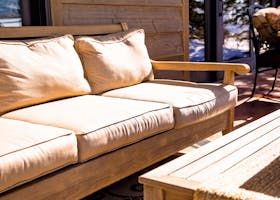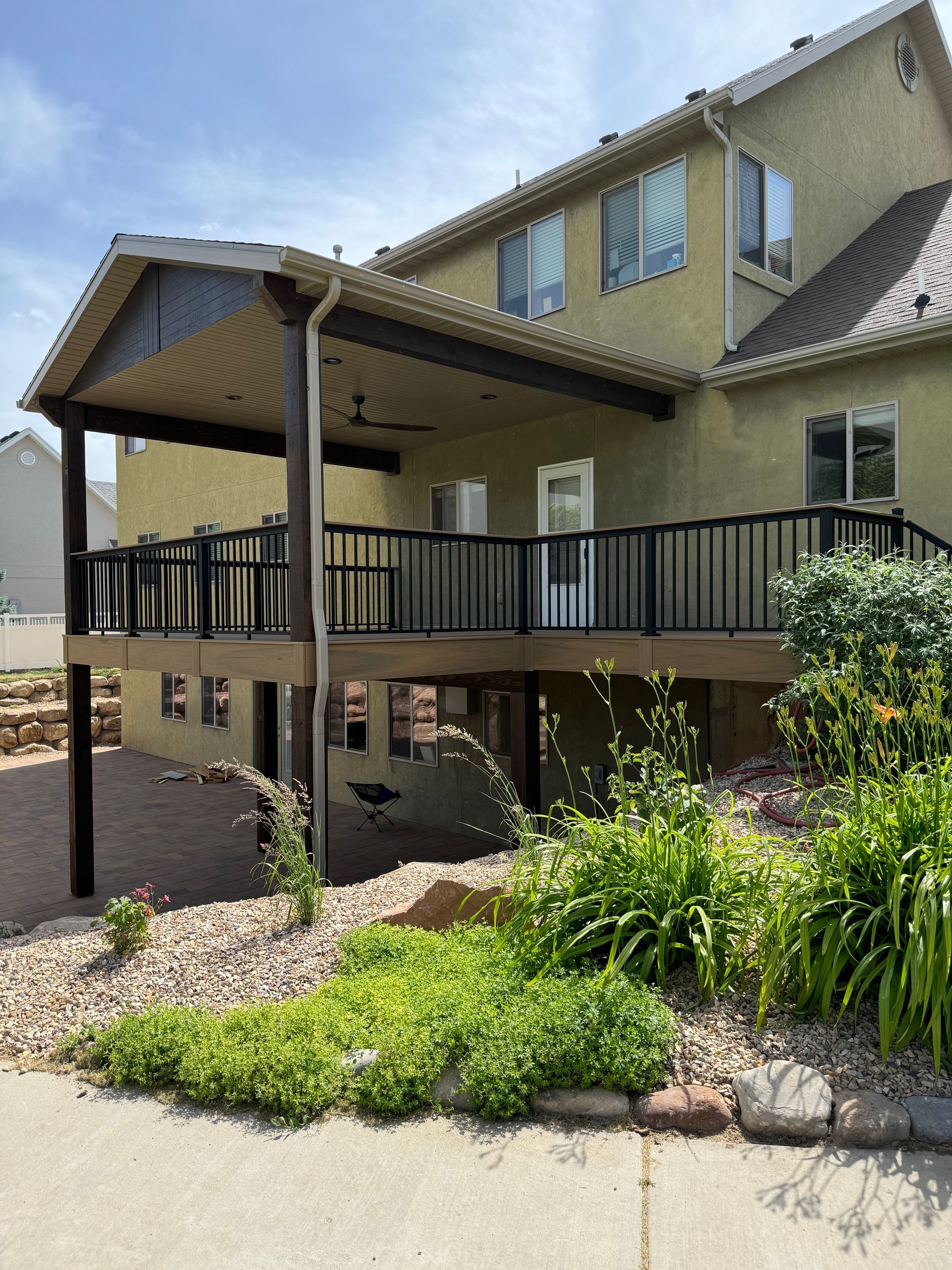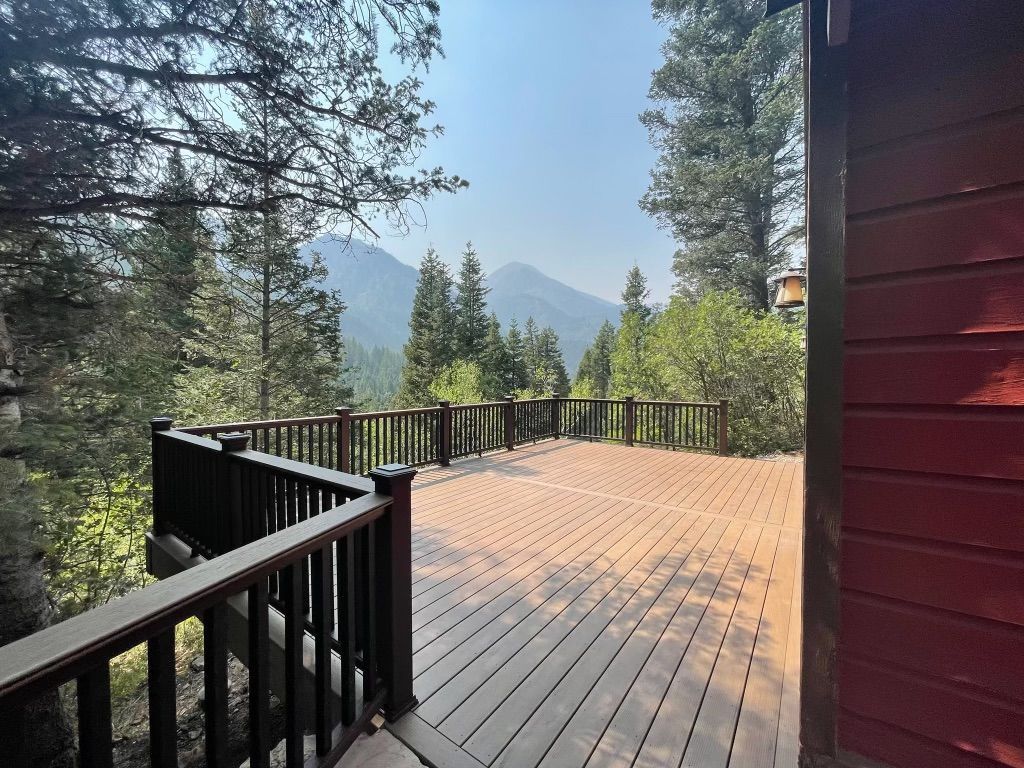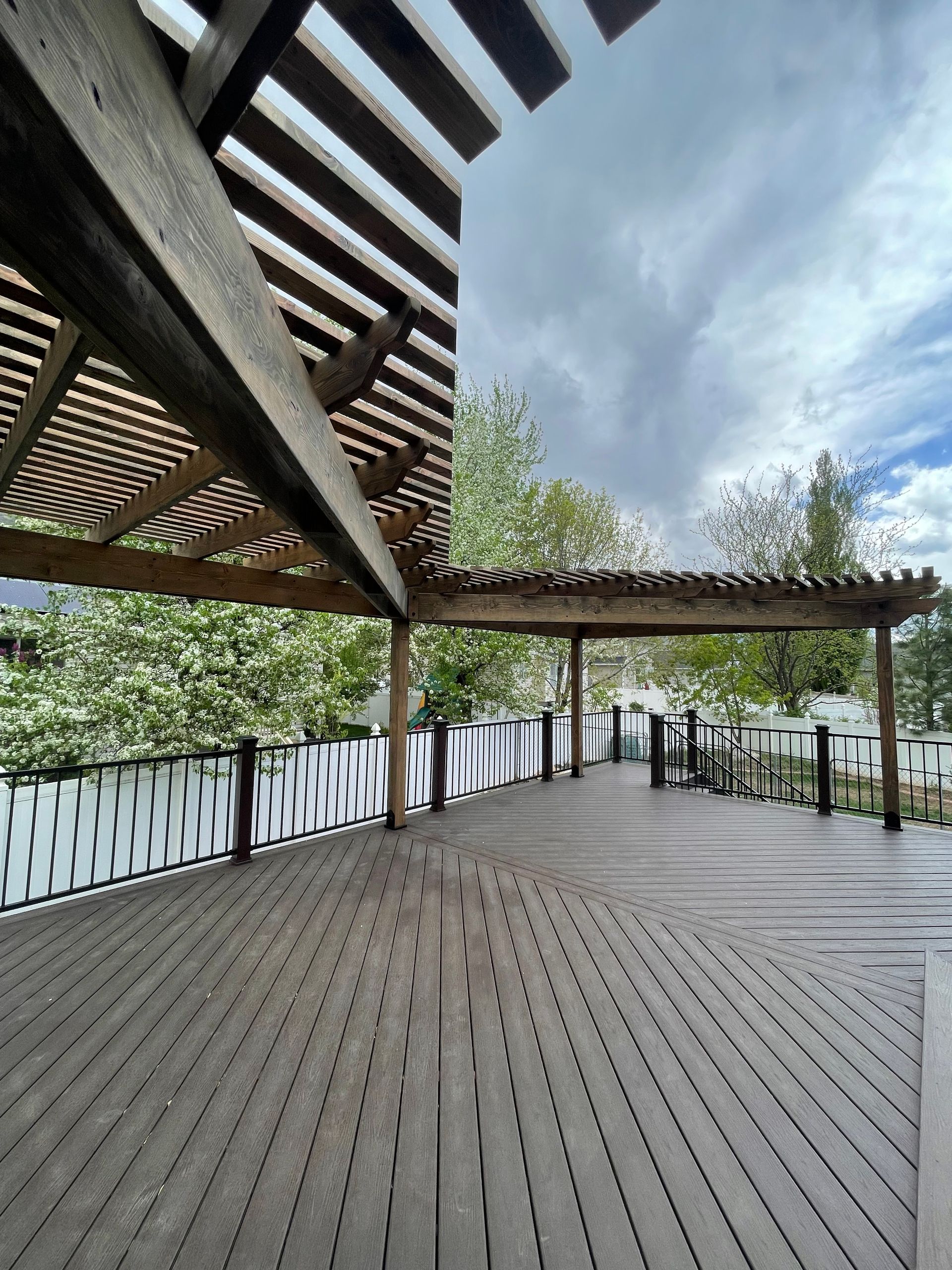Our Utah Deck Work
By: Nick Londono
We are so proud of the work that we do here in Utah.
While building a deck in Utah, there are some specific guidelines that are necessary to follow. It is important to follow all permitting and code rules as well as best practices for building decks in Utah. As Utah is a location that experiences moderate winters with snowfall, it is important to plan for harsher weather with your deck
Here are some important considerations for building a deck in Utah:
- Building codes: Utah follows the International Residential Code (IRC) for deck construction. The IRC provides guidelines for size, height, and spacing of deck components, as well as the required strength and durability of materials.
- Permits: A building permit may be required for deck construction, depending on the size and complexity of the project. Contact your local building department for more information.
- Climate considerations: Utah can experience harsh weather conditions, including heavy snow and strong winds. Your deck design should take these conditions into account and be built to withstand them.
- Footings and support structure: Your deck's footings and support structure must be able to support the weight of the deck, any furniture, and the people who will use it.
- Drainage: Adequate drainage must be provided to prevent water from pooling under the deck, which can cause rot and other damage.
- Fire safety: Decks constructed of combustible materials must comply with fire safety codes and regulations.
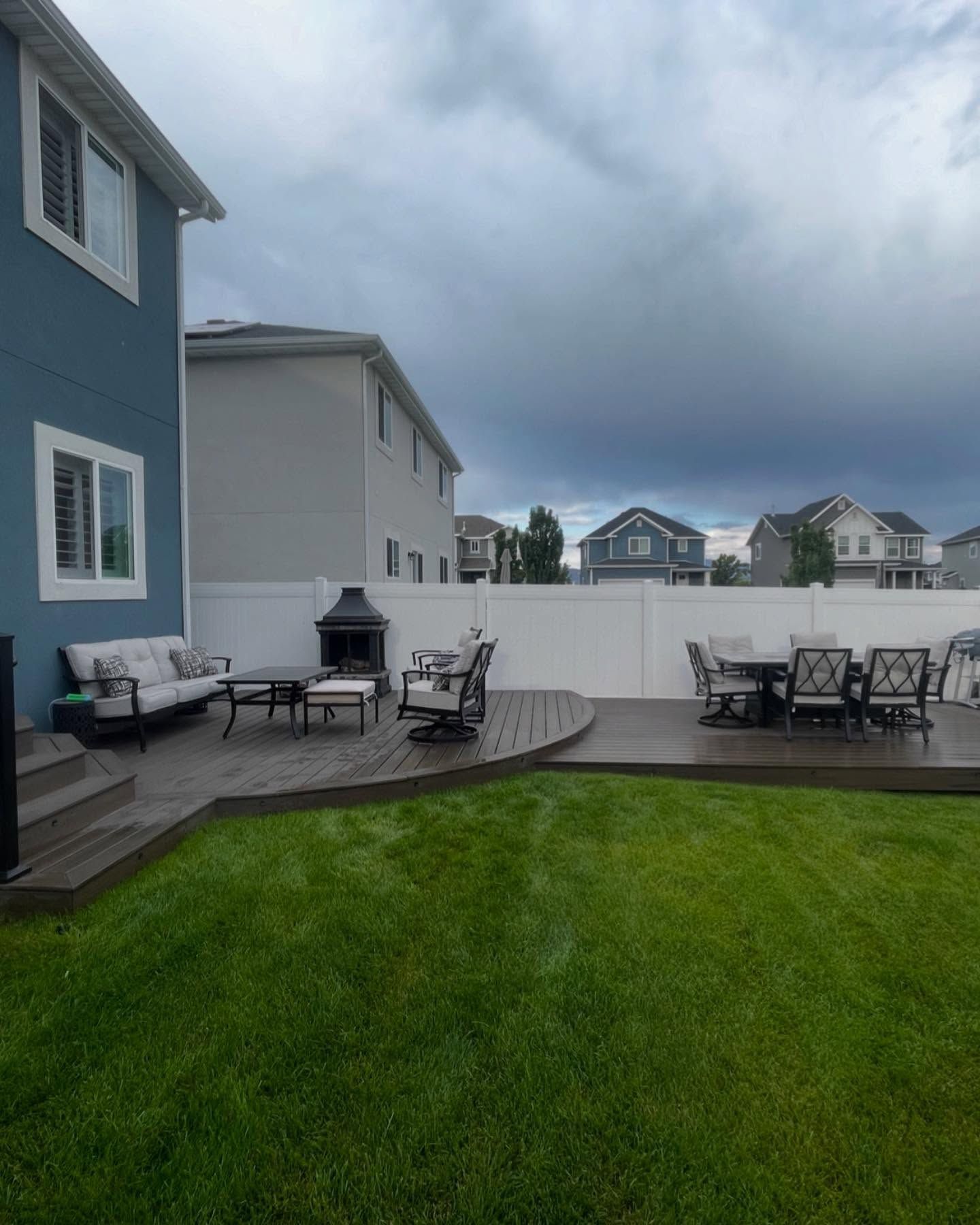
By Nick Landono
•
January 20, 2025
Your deck is more than just a place to unwind or entertain—it’s an extension of your home, offering comfort, style, and a connection to the outdoors. But to keep it looking beautiful and functioning well for years to come, regular maintenance is key. Whether you have a wood deck, composite decking, or any other material, keeping your outdoor space in top condition requires some know-how. In this Deck Maintenance 101 guide, we’ll walk you through essential tips to preserve your deck's beauty, prevent costly repairs, and ensure it stands up to the elements season after season. 1. Regular Cleaning Is Essential The foundation of good deck maintenance is keeping it clean. Dirt, debris, leaves, and even algae or mold can build up over time, leading to discoloration, slippery surfaces, or even damage if not addressed. How to Clean Your Deck: Sweep Regularly: Sweep your deck every couple of weeks to remove dirt, leaves, and debris. This prevents buildup that can lead to staining or clogging the gaps between deck boards. Wash Seasonally: A thorough wash is recommended at least once a year. Use a deck cleaner designed for your deck’s material, whether wood or composite. A pressure washer can be useful, but be careful not to use too high a setting, as it can damage the wood or loosen fasteners. Tackle Mold and Mildew: In damp climates, mold and mildew can grow quickly. Treat your deck with a mold-resistant cleaner or a homemade solution (like vinegar and water) to remove these growths before they become a long-term problem. 2. Protect with Seals and Stains (For Wood Decks) If you have a wood deck, sealing and staining are crucial to prolong its lifespan and maintain its appearance. Without proper protection, your deck’s wood can dry out, crack, warp, or discolor over time. Sealing and Staining Tips: Sealing: Wood decks should be sealed with a high-quality water-repellent sealant every one to two years. This helps to protect the wood from moisture, which can cause swelling, warping, or rot. Always make sure the deck is completely dry before applying any sealant. Staining: Staining your deck not only enhances the wood’s natural beauty but also adds an extra layer of protection. If you prefer a natural look, choose a transparent or semi-transparent stain. For a more opaque finish, go with solid stains. Reapply the stain every two to three years, depending on wear and exposure. Check for Signs of Wear: Regularly inspect the wood for signs of fading, cracking, or peeling. If the stain or sealant is worn down, it's time to reapply. 3. Inspect for Damage and Wear Regular inspections are one of the best ways to keep your deck in top shape and prevent costly repairs down the road. By spotting issues early, you can address them before they become more serious. What to Check for: Loose or Rusted Fasteners: Inspect screws, nails, and bolts regularly to make sure everything is tight and secure. Over time, fasteners can rust or become loose, which could result in a hazardous surface. Replace any rusted or damaged hardware. Cracked or Splintered Boards: Look for any boards that are cracked, splintering, or rotting. Replace damaged boards as soon as possible to avoid injury or further damage to the deck. Warped Wood: Over time, exposure to the elements can cause wood to warp. If you notice warping or cupping in the deck boards, it might be time for replacement or to have the boards straightened. Check the Support Structure: Don’t forget to check the underlying frame or structure of your deck. Look for any signs of sagging or damage to the joists or beams. If anything looks amiss, it’s best to have a professional evaluate it. 4. Apply a Protective Finish for Composite Decking If you have composite decking, you're in luck when it comes to maintenance—composite materials typically require less upkeep than wood. However, that doesn’t mean they’re entirely maintenance-free. Protecting Composite Decking: Routine Cleaning: Composite decking can attract dirt and stains, so regular sweeping and washing are still important. Use a gentle detergent or a special composite deck cleaner to maintain its luster. Avoid Harsh Chemicals: Be careful with harsh cleaning chemicals, as they can strip away the finish on composite decks. Stick to mild soap and water, and avoid bleach unless necessary to remove stains. Resist Staining: Composite decks are less likely to stain than wood, but food, drinks, and other substances can still leave marks. Wipe up spills promptly to avoid discoloration. 5. Keep the Gaps Between Deck Boards Clear Over time, dirt and debris can accumulate between the gaps in your deck boards, blocking water drainage and causing mold or mildew to form. This can weaken the structural integrity of your deck. How to Keep the Gaps Clean: Use a Putty Knife or Similar Tool: Gently scrape out dirt or debris between the boards using a putty knife or a deck gap cleaner. Be sure to do this regularly to prevent buildup. Inspect Drainage: Make sure that water flows freely through the gaps between the boards. If the drainage is blocked, water can pool on the deck, potentially causing damage over time. Ensure the deck is properly sloped to promote water runoff. 6. Protect Against the Elements The sun, rain, and temperature fluctuations can all take a toll on your deck’s appearance and longevity. Here’s how to protect your deck from the elements: UV Protection: The sun’s UV rays can cause wood to fade and dry out, so applying a UV-resistant sealant or stain is essential to keep your deck’s color vibrant. For composite decks, look for products specifically designed to protect against UV damage. Rain and Moisture Protection: Excess moisture can cause wood to swell, warp, or rot. Ensure your deck has proper drainage, and consider adding a waterproof sealant to shield the wood. If you live in an area with heavy rain, you may also want to install a canopy or cover for added protection. Winter Care: In colder climates, snow and ice can cause significant damage to your deck. Clear snow and ice regularly to avoid excess weight on the surface, and avoid using salt or de-icing chemicals, as they can damage the wood. Opt for a plastic shovel or broom instead. 7. Add Protective Accessories Certain accessories can help prolong the life of your deck while enhancing its comfort and appeal. Outdoor Rugs: These can protect your deck’s surface from scratches and stains while adding a stylish touch. Just make sure to lift the rugs periodically to allow airflow and avoid mold buildup underneath. Deck Furniture Covers: During the offseason or if your deck will be unused for an extended period, use furniture covers to protect your outdoor furniture from rain, dirt, and UV rays. Deck Mats: Place mats in high-traffic areas or where grilling takes place to protect your deck from spills, grease, and wear. Conclusion: Keep Your Deck Looking Great All Year Long Deck maintenance doesn’t have to be complicated, but it does require attention to detail. With regular cleaning, inspections, and the right protective measures, you can ensure that your deck stays beautiful and safe for years to come. Whether you have a wood deck, composite materials, or a custom design, taking the time to properly maintain your deck will pay off in long-lasting beauty and performance.
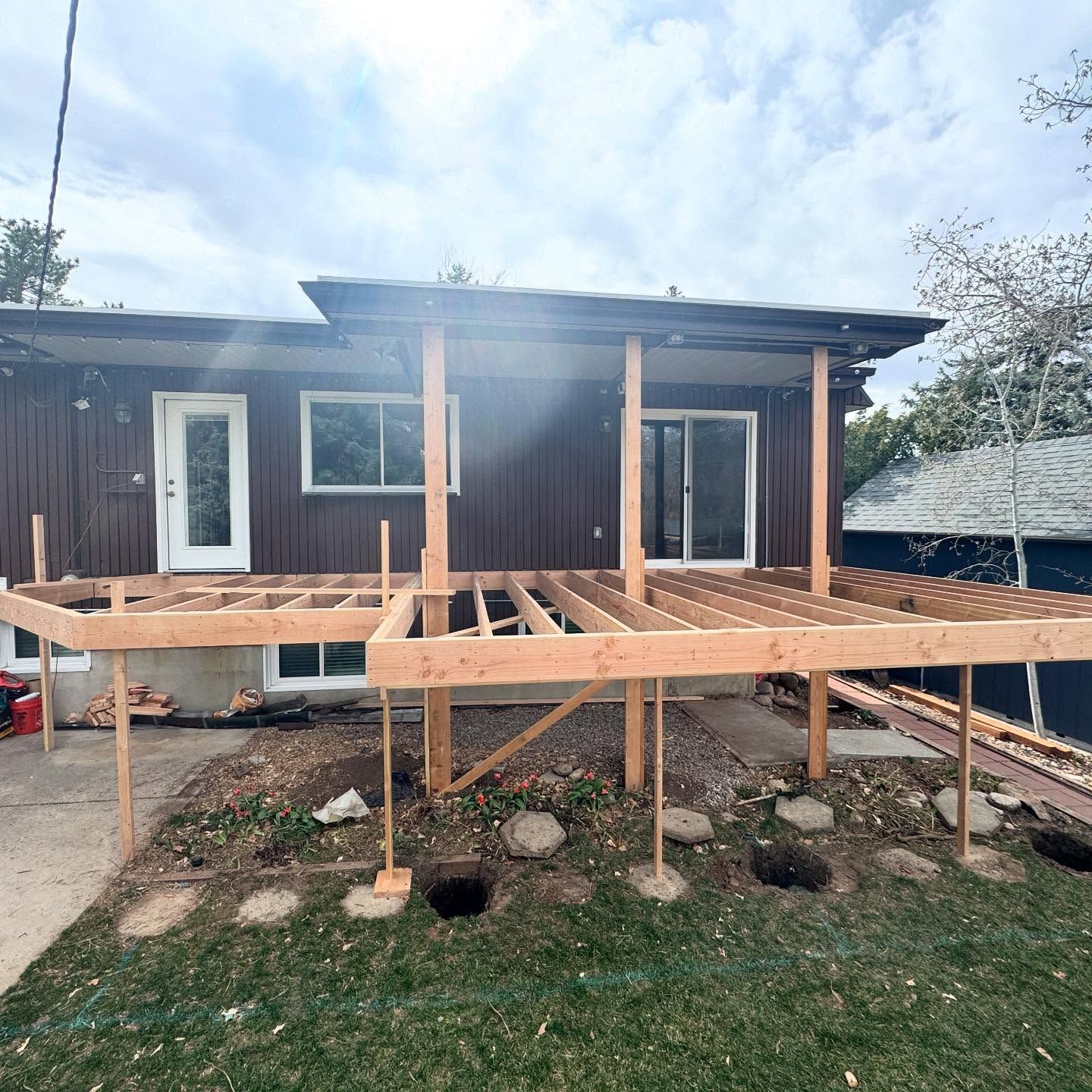
By Nick Londono
•
January 17, 2025
When it comes to outdoor living, your deck can be so much more than just a place to place a grill or a few chairs. With the right design ideas, you can transform your deck into an expansive, functional, and stylish extension of your home. Whether you have a small balcony or a sprawling backyard, there are endless possibilities for maximizing your outdoor space. Here are some creative deck design ideas to inspire your next outdoor renovation! 1. Multi-Functional Zones One of the best ways to maximize a deck’s potential is to create distinct zones for different activities. Whether you’re entertaining, dining, or lounging, dividing your space into functional areas will allow you to use your deck to its fullest. Dining Area: Consider adding a dedicated space for dining with a sturdy table, comfortable chairs, and stylish lighting. Lounge Area: Create a cozy lounge with outdoor sofas or cushioned chairs and a coffee table, perfect for relaxation or casual conversation. Work or Study Area: If you work from home or just enjoy a change of scenery, designate a quiet corner with a compact desk and comfortable chair. A portable umbrella or retractable awning can help keep you shaded and focused. By zoning off specific areas, your deck becomes a versatile living space that can accommodate a variety of activities. 2. Vertical Gardens and Green Walls If you're working with limited square footage, one of the best ways to maximize space is to think vertical. Vertical gardens or green walls are a brilliant way to add lush greenery without taking up valuable floor space. You can install trellises, hanging planters, or even a pre-planted vertical garden system. These walls of greenery can help bring in natural beauty and provide privacy. Plants like ivy, climbing roses, or even herbs and vegetables can thrive in vertical planters, creating a stunning natural backdrop for your outdoor space. Greenery can also help soften the edges of your deck, giving it a more organic and inviting feel. 3. Built-In Seating Solutions When you're limited on space, multi-functional furniture is key. Built-in seating is a stylish and practical way to maximize deck space without overcrowding it with bulky furniture. Bench Seating: Create bench seating along the perimeter of your deck, or integrate it into the railing system. Adding cushions can ensure comfort while maintaining a sleek, modern look. Storage Benches: For added convenience, opt for built-in benches with hidden storage compartments underneath. These provide a great place to stash cushions, gardening tools, or outdoor games. Corner Seating: If you have an oddly-shaped deck or smaller areas to work with, corner seating can help make the most of those corners, turning them into cozy, functional spots. This kind of built-in seating is perfect for creating an intimate, organized feel while also providing ample seating for guests. 4. Level Up with a Multi-Tiered Deck For larger decks or sloped outdoor areas, a multi-level design can make the most of every inch. Multi-tiered decks not only add visual interest and depth, but they also allow you to segment your outdoor space into distinct areas for lounging, dining, or even gardening. Consider incorporating features like a small platform for a hot tub, an elevated dining space with great views, or a lower-level seating area near a fire pit. This type of design works wonders for creating a flow between various zones, giving the illusion of a larger space while maintaining a functional layout. 5. Incorporate Built-In Planters Planters are an essential element in any outdoor space, and they can be especially effective in maximizing small or tight decks. By integrating planters directly into the structure of your deck, you can save floor space while adding greenery and charm. Rail Planters: Install narrow planter boxes along the deck railing for a visually appealing way to add plants without taking up extra space. Integrated Planter Seats: Combine seating and planters into one by adding planters along the base of built-in benches. This creates an attractive, cohesive look while providing room for more greenery. Railing Planters: Hanging planters can be easily attached to the railings, adding color and dimension without occupying valuable square footage. These built-in features ensure your plants stay organized, and your deck remains spacious and uncluttered. 6. Use of Reflective Surfaces In small outdoor spaces, the right design choices can make the area feel bigger and brighter. One way to achieve this is by incorporating reflective surfaces like mirrors, glass panels, or even polished metal accents. Glass Railing: If you’re working with a deck that has a beautiful view, consider opting for glass railing. This allows for unobstructed sightlines while still providing safety, making your deck feel more expansive. Mirrors: Adding a large outdoor mirror can visually enlarge the space by reflecting natural light and the surrounding greenery. It can also serve as a stunning focal point. Reflective surfaces can help amplify light, making your deck feel airy, open, and spacious. 7. Outdoor Kitchen and Bar Area For those who love to entertain, an outdoor kitchen is a game-changer. With the right setup, you can maximize the utility of your deck by turning it into a fully functional cooking and dining area. Built-In Grill or Smoker: Having a built-in grill, smoker, or even a pizza oven allows you to cook while staying engaged with your guests. Bar Area: If you have the space, consider adding a bar counter with seating for a more social vibe. You can also incorporate a wine fridge, sink, and storage for glasses and bar tools to make entertaining even easier. Compact Appliances: If your deck is on the smaller side, opt for compact, multi-purpose appliances such as a fold-out grill or a mini-fridge that doesn’t take up too much space but still elevates your cooking experience. An outdoor kitchen not only makes your deck more functional but also adds luxury and convenience for anyone who loves hosting outdoor gatherings. 8. Creative Flooring Solutions The flooring of your deck plays a crucial role in how spacious and inviting the area feels. Opting for creative or unique flooring materials can add personality and functionality to your deck design. Wooden Tiles or Decking Tiles: If you want to avoid the monotony of traditional deck materials, consider using interlocking wooden tiles that create a rich, layered look. Pergola with Pavers: Lay down large pavers beneath a pergola to create a designated space for dining or relaxing, offering a distinct yet cohesive flow from the house to the outdoors. Outdoor Rugs: For a soft, welcoming touch, add an outdoor rug to define a seating area or a dining space. Choose durable, weather-resistant fabrics that can withstand the elements while adding a cozy touch. Creative flooring can unify the design of your deck and enhance the functionality of each zone. 9. Optimize Privacy with Screens or Fencing In any outdoor space, privacy is key. You can maximize the comfort of your deck by adding screens, trellises, or fencing that block out views from neighbors or the street, creating a more peaceful environment. Privacy Screens: Use slatted screens, latticework, or bamboo fencing to keep your deck feeling more intimate and secluded. These are especially useful if you have a small deck in a highly visible area. Hanging Plants or Curtains: For a softer look, consider hanging outdoor curtains or planters to create a more private, relaxing ambiance. Privacy features will help you make the most of your outdoor space, making it feel like your own private oasis. Conclusion: Design Your Dream Deck Maximizing your deck space is all about creativity and thoughtful design. Whether you’re working with a large, open area or a compact space, there are endless ways to enhance both functionality and style. From creating multi-functional zones to adding greenery and privacy elements, these creative deck design ideas will help you get the most out of your outdoor space. Ready to transform your deck? Reach out to us today to discuss how we can help you maximize your outdoor living area with custom design solutions that fit your style and needs.
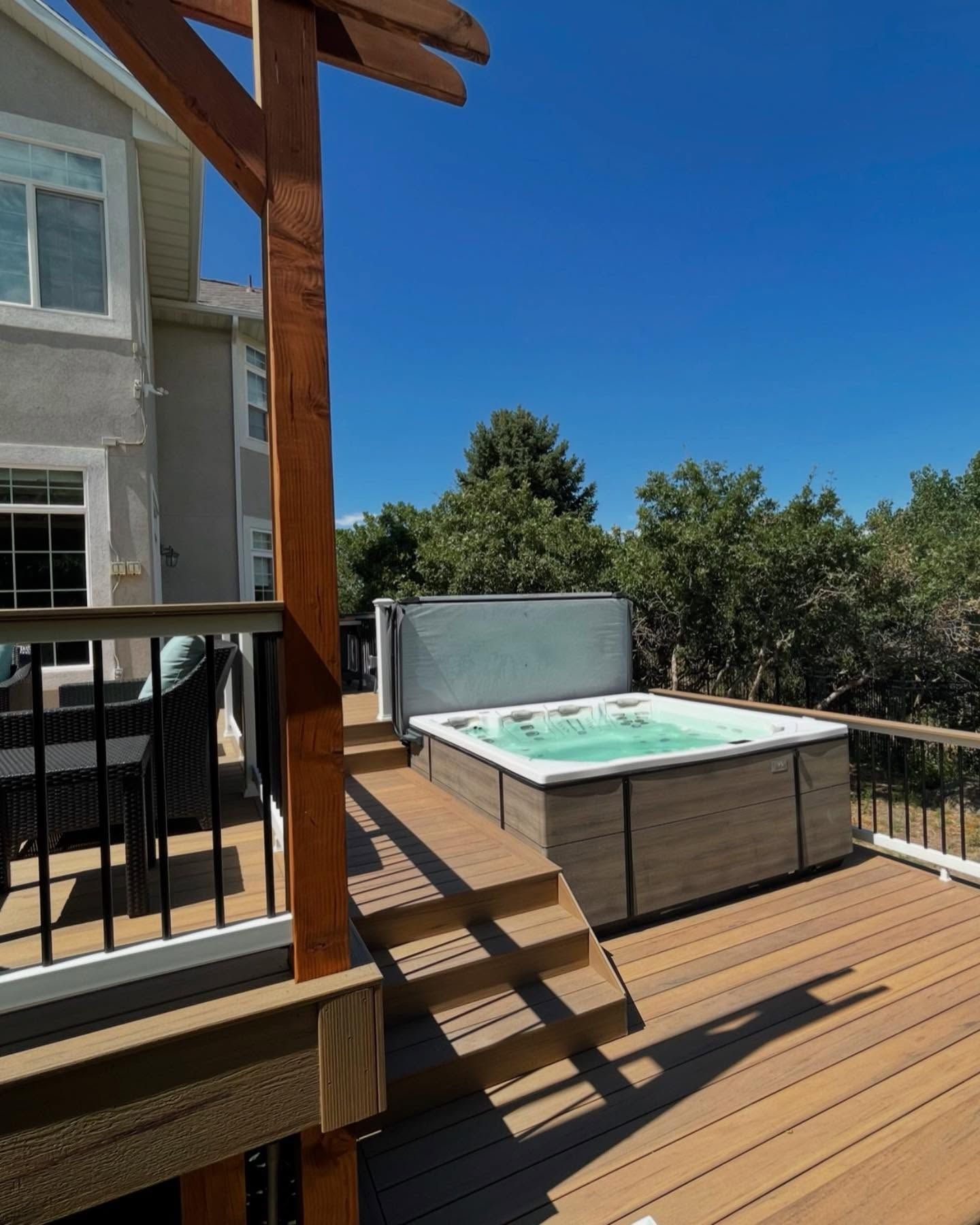
By Nick Londono
•
January 17, 2025
Your deck is more than just an outdoor space; it’s an extension of your home and an opportunity to create a sanctuary that blends style, comfort, and functionality. As the weather warms and people flock outdoors, the latest deck trends are redefining what it means to entertain, relax, and enjoy nature. If you’re looking to elevate your deck, here are the top trending features to inspire your next outdoor upgrade. 1. Sustainable and Eco-Friendly Materials In today’s world, sustainability is more important than ever. Homeowners are increasingly choosing eco-friendly materials for their outdoor spaces, from composite decking made from recycled wood fibers and plastics to FSC-certified wood options. These materials not only reduce environmental impact but are also durable, low-maintenance, and long-lasting. Another popular choice is bamboo decking, known for its rapid renewability and natural beauty. By selecting eco-conscious materials, you’ll not only create a stunning deck but also make a positive contribution to the environment. 2. Integrated Lighting for Ambiance Lighting can completely transform the atmosphere of your deck, turning it from a daytime retreat into a cozy evening escape. Integrated lighting is one of the hottest trends right now, with options like built-in deck rail lights, step lighting, and LED accent strips along the perimeter. Dimmable lighting, smart lighting systems, and even solar-powered lights can add a warm, inviting glow that allows you to enjoy your deck long after the sun sets. Whether you’re hosting a party or simply relaxing under the stars, proper lighting sets the perfect mood for any occasion. 3. Outdoor Kitchens and Bars The demand for outdoor kitchens has skyrocketed in recent years, and it’s easy to see why. The idea of having a fully functional kitchen just steps from your home is not only practical but also an invitation to entertain. Imagine grilling steaks, preparing fresh salads, and serving drinks all while enjoying the outdoors with friends and family. From built-in grills and pizza ovens to refrigerators, sinks, and wine coolers, outdoor kitchens have come a long way. Adding a bar area with stools can make your deck the ultimate gathering spot. Customization is key – choose materials that complement your home’s interior and consider adding a retractable canopy or pergola for shade and comfort. 4. Smart Technology Integration Smart home technology isn’t just for the indoors anymore. Modern decks are now being designed with integrated smart features to enhance convenience and functionality. Think smart thermostats to control outdoor heaters, Wi-Fi-enabled lights and speakers, or even outdoor TVs and projection screens for movie nights under the stars. Automating your deck with these high-tech options allows you to easily control your outdoor environment with the touch of a button. Whether it’s adjusting the lighting, setting the mood music, or activating a fountain, the possibilities are endless with smart tech. 5. Multi-Level Decks and Zones If you have a larger outdoor space, consider creating a multi-level deck that includes separate zones for different activities. For example, you might have one area dedicated to dining, another for lounging, and a third for a fire pit or hot tub. Multi-level decks create visual interest, improve the flow of your outdoor space, and provide designated areas for different functions. Adding barriers like privacy screens, pergolas, or trellises can also help separate zones and add to the overall aesthetic of your deck. 6. Lush Landscaping and Greenery Incorporating nature into your deck design is a timeless trend that’s growing stronger. Whether it’s strategically placed potted plants, vertical gardens, or green walls, lush landscaping adds a touch of tranquility and beauty to your outdoor space. Consider adding a mix of perennial plants, shrubs, and even small trees to create a green oasis. If you’re looking for something low-maintenance, succulents, and drought-resistant plants are a great choice. Vertical gardens or hanging planters can also be ideal for adding greenery without taking up too much space. 7. Fire Features and Water Elements Fire pits and outdoor fireplaces have been popular for years, and their timeless appeal continues to dominate deck designs. They’re perfect for cooler evenings, providing warmth, ambiance, and a gathering point for friends and family. However, water features are also making a strong statement on modern decks. Fountains, waterfalls, or even small reflecting pools can introduce a calming element to your deck. The sound of running water can enhance relaxation, making your deck feel like a personal retreat. 8. Durable and Comfortable Furniture When it comes to decking out your outdoor space, comfort is key. Modern furniture now combines style with durability, offering sleek designs that are built to withstand the elements. Think weather-resistant cushions, low-maintenance wicker, or even teak seating that looks elegant and feels great. Outdoor furniture is now designed with both aesthetics and comfort in mind, from sectional sofas perfect for lounging to ergonomic dining chairs that let you enjoy meals outdoors for hours. Plus, many pieces now come with features like built-in storage for easy organization and cleaning. 9. Retractable Shades and Pergolas Sun exposure can be both a blessing and a curse. While it’s lovely to bask in the sun, too much can make your outdoor space uncomfortable. That’s where retractable shades, awnings, and pergolas come into play. These versatile additions allow you to control the amount of sunlight your deck gets, providing relief from the heat and protecting your furniture from UV damage. Modern pergolas are often equipped with adjustable louvered roofs or retractable fabric shades, giving you the flexibility to block out the sun when needed or enjoy it when desired. Conclusion: Create Your Perfect Deck Elevating your deck is about more than just keeping up with trends – it’s about designing a space that reflects your lifestyle and enhances your connection with the outdoors. Whether you’re after sleek and modern aesthetics, sustainable features, or a multi-functional space for entertaining, the possibilities are endless. By incorporating some of these trending features, you can transform your deck into the perfect setting for modern living, whether you're relaxing alone or hosting friends and family. Ready to elevate your deck? Contact us today to get started on your outdoor transformation!
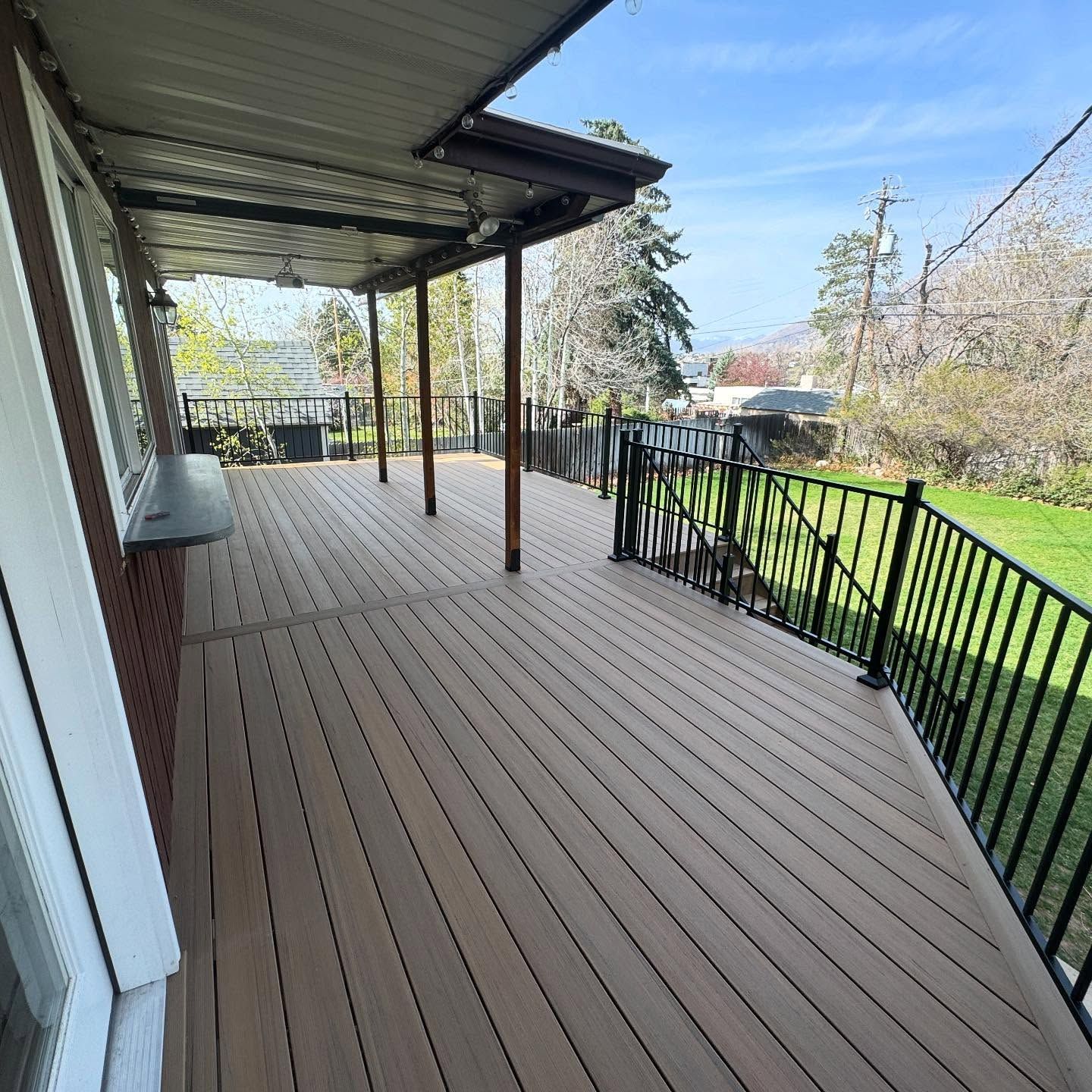
By Nick Londono
•
March 15, 2023
If you're looking to enhance the appeal and functionality of your outdoor deck, adding a custom pergola or a roof structure can be a savvy idea! When done right, these structures can not only provide shade and shelter from the elements, but also add aesthetic value to your deck. In this blog, we'll explore the benefits of adding a pergola, awning or other shelter to your deck. Shade and Shelter Whether you're enjoying a hot summer day or trying to escape the rain, a roof structure can keep you protected from the elements. In Utah this can be especially beneficial and even help keep snow off of your deck in the winter, so you can have a dry outdoor space. Increased Privacy Another benefit of adding a pergola to your deck is the increased privacy it provides. Adding a structure like this to your deck also provides an easy way to hang privacy curtains or blinds around your deck. Aesthetic Value A custom built roof or pergola can add design interest and can be an easy way to increase the value of your house! Additional Space for Entertaining Having that custom roof structure adds additional space for entertaining guests. You can host outdoor parties or barbecues under your pergola, providing your guests with a shaded area. Energy Efficiency If installed in the right location, a roof or awning can provide energy efficiency benefits. It can help regulate the temperature of your home by blocking the sun's rays in the summer and providing insulation in the winter. Thus lowering your energy bill! Adding a pergola is an investment that stands the test of time, enhancing the beauty and functionality of your outdoor space while increasing your home's value.

